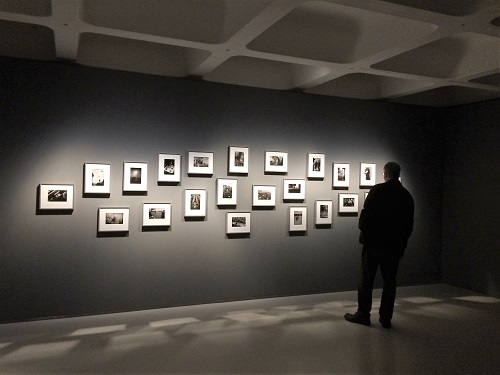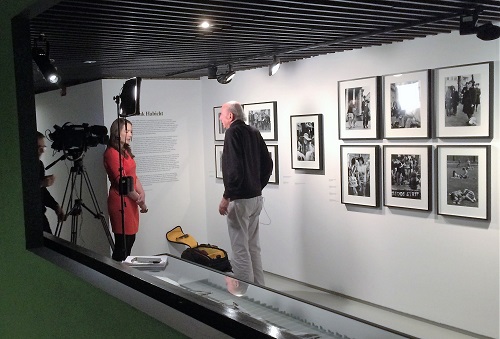
A perspective of Britain: Stange and Familiar gathers work of some of the biggest names in photography
Strange and Familiar: a nation revealed
A new exhibition at the Barbican collects images of Britain created from an overseas perspective. Jonathan Ives wandered the walls to see what is revealed of Britain by those who came to visit.

A perspective of Britain: Stange and Familiar gathers work of some of the biggest names in photography
With the UK going through another reassessment of its relationship with the rest of the world, the opening of the Barbican’s latest photographic exhibition seems particularly well timed. Strange and Familiar: Britain as Revealed by International Photographers features the work of 23 photographers, each recording British life from their own perspective. All of them came to the UK from overseas, all have their own styles and interests. The result is a startling and moving account of a nation seen from the outside; or, more accurately, of a nation seen from the inside by outsiders.
The exhibition includes the work of some of the most respected names in photography and displays some of the most celebrated aspects of British culture. The coronation, City financiers and the swinging sixties are all there; so too the bus queues, the bowler hats and the street markets. But also captured are some of the less celebrated, less comfortable aspects of Britain: the daily realities of sectarianism in Northern Ireland; the lonely bleakness of city life; the raw and desperate poverty of 1980s Glasgow. Through the eyes of these image-makers, the whole of a nation is laid bare and not all of it is as palatable as the postcards might have tourists believe.
Martin Parr, himself among the greats of modern photography, curated the exhibition and speaking at the opening he explained that Strange and Familiar had its roots in his student days, when he would pick up any photography collections he could find and could afford.
“I’m completely obsessed with collecting photography books,” he said. “I realised that many people had come to Britain to take photographs but often we hadn’t seen them. And it’s interesting to understand and see that we’re quite a strange nation. They found their own little world and with incredible insight they found the thing that really fascinates them.”
Parr explained that he was pleased to be able to include the work of some very familiar names – none more familiar than Henri Cartier-Bresson – and also the work of new photographers. He was also delighted to be able to welcome so many of them to the opening of the exhibition. They in turn dutifully subjected themselves to round after round of interviews and, perhaps the ultimate discomfort for a photographer, having their picture taken.
The exhibition runs chronologically and begins with Edith Tudor-Hart, an Austrian who came to London in 1933 and set about documenting the social issues she found. A committed Communist, Tudor-Hart’s images captured a nation separated by wealth. The juxtaposition of Poodle Parlour, London, showing a pampered animal’s coiffure, with Gee Street, Finsbury, London, an image of a family of seven in their cramped back yard, made a political point clearly, as effective today as it was then.
Henri Cartier-Bresson came to London a few years later, in 1937, having been commissioned by the French picture magazine Regards to cover the coronation of George VI. His approach was to focus on the crowds rather than the crowned, capturing the reactions of people observing and celebrating the event, noting the school caps and the top hats that were such a notable feature of British life. He returned for a number of royal events, including the wedding of Princess Anne in 1973 and for the Queen’s silver jubilee in 1977 but he also found time to find beauty and character in Blackpool, making images of the summer crowds for Vogue.
The contradictions of class and working cultures are a recurring theme through the exhibition. Robert Frank, a Swiss-American, came to the UK in the early 1950s, visiting the City of London and the village of Caerau for his series London/Wales. Here the contrast of working lives within the formality of British banking and the tough, raw world of Welsh mining is stark and pointed.
While London has always been a draw for visitors, Cas Oorthuys also visited Oxford and Cambridge in search of the idiosyncrasies of British life. Paul Strand went to the Outer Hebrides and Bruce Davidson’s 1960 picture essay Seeing Ourselves as an American Sees Us, shot for The Queen magazine, prompted a return visit in 1965 during which he roamed the UK, making pictures in Brighton, Hastings and Wales. The contrasts of lives in the country and city, in poverty and wealth are repeatedly explored.
In the late 1960s the “pop credentials” of Liverpool drew Candida Höfer to the city, where she captured the buses and Yates’s along with the car factories and the ferries. At the same time Gary Winogrand was travelling around the country, finding plenty of monocles and morning coats but also the streets and people and plastered pub ceilings of a different nation.
Among the most striking images of the exhibition, partly owing to their size, partly to the impact of portraits in extreme close-up, are the images of Bruce Gilden. Taken in the Black Country in 2014 and Middlesex in 201, these tightly cropped, starkly lit images capture faces that show every line and blemish in uncompromising detail. These are faces with working class lives written deep upon them. Speaking at the show’s opening, Gilden told an interviewer why these faces resonated with his own experience. “People are being forced out of their city, just as I was forced out of Manhattan,” he said.
No less striking are Raymond Depardon’s photographs of Glasgow taken in 1980 as part of a commission by the Sunday Times. The pictures document a poverty-ravaged city through dark, desolate images that occasionally flash with colour. Shuttered shops and lowering shipyards, the poor and the pissed spending their days on the streets. The gleaming red of a Vauxhall Viva against the dark-grimed background of a tenement. Joy and pain are etched into faces with desperation evident or never far away.
The exhibition notes that Depardon’s images were deemed too bleak to publish but Ian Jack, who was then with the Sunday Times and worked with Depardon on the project, has suggested that this was not quite the case. Writing in the Guardian, Jack explains that the idea of The Sunday Times Magazine series was to show cities that were worth visiting in spite of their reputations. “We worked together in Glasgow for a week or so, and it became clear that Raymond wasn’t interested in photographing CR Mackintosh’s art school, Greek Thomson’s churches, or the bosky dells of the Botanic Gardens,” Jack writes. “What drew him, as it had many photographers in the past, were the black tenements waiting for the wrecker’s ball, the drunk sprawled on the pavement, the grubby child pushing the pram. In others words, the Glasgow we knew about, rather than the Glasgow we didn’t.” For this reason the images were never used and lay unseen until uncovered for this exhibition more than three decades.
Depardon’s pictures are brutal images of Britain’s recent past but the whole exhibition serves as a reminder of what Britain as a nation has been and has chosen to become. In the late 1990s and early noughties the American photographer Tina Barney undertook a modern grand tour of Europe, capturing images of an Old World elite. Her images of Britons of wealth and status show the familiar and stolid faces of an ebbing elite but these portraits, as the curator’s notes remark, “provide a window into a world that appears both melancholic and endearing”. Speaking to the Leisure Review at the exhibition launch, Barney noted that so many things that seem so permanent prove ephemeral. “I went to China looking for the old,” she said, “and barely found any of it left.”
Jonathan Ives is the editor of the Leisure Review and a frequent, although frequently mystified, visitor to our great galleries.
Ian Jack’s article in the Guardian inspired by Strange and Familiarcan be read via www.theguardian.com/commentisfree/
Full details of the Strange and Familiar exhibition at the Barbican gallery is available via www.barbican.org.uk
The Leisure Review, April 2016
© Copyright of all material on this site is retained by The Leisure Review or the individual contributors where stated. Contact The Leisure Review for details.
![]() Download a pdf version of this article for printing
Download a pdf version of this article for printing
